Local Sporting Stars From the Mid-Twentieth Century
During the period from the 1930s until the 1950s the old ‘City of Mordialloc’ district (Mordialloc, Parkdale and Mentone) was the home for several people who became very successful in a variety of sports at a national and international level. Some of these stand out, so let us look briefly at their careers.
Leo O’brien: Test Cricketer
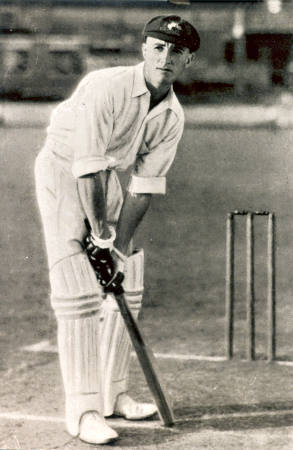
Leo O’Brien, Australian Test Cricketer. Courtesy Brian Quinn, Kingston Collection.
Mentone boy, Leo O’Brien, first came under notice when he was awarded a gold medal by the St Patrick’s parish priest for gaining his Merit Certificate at the tender age of thirteen in 1919. For the rest of his life Leo was noted more for sporting success than academic work.
He began playing cricket for Mentone as a teenager and made a century in 1924. His good form was noticed by people connected with Richmond in the Melbourne District competition. Leo was selected to play for Richmond and did well enough to be picked in the Victorian side in 1929-30. His success continued and when the England team toured Australia in 1932-3 O’Brien was named in a lead-up game in an Australian XI as a possible opening bat in the Test team. A gritty 46 against the English quicks secured his place in the Melbourne Test over the New Year period. He failed in that encounter and was dropped until the Sydney Test where he made 61. Leo was left out of the squad that toured England in 1934 but went to South Africa in 1935-6 where he made 59 and 48 in his two Test appearances. When England returned for the 1936-7 series O’Brien played in the First Test but failed and his Test career was over.
During 1935 Leo O’Brien, Stan McCabe, Bill O’Reilly and Chuck Fleetwood-Smith were called before the Australian Cricket Board to discuss a problem that had arisen. Bradman, as Test Captain, had become uneasy about Stan McCabe’s popularity and the suspicion that some team members might have preferred him as captain. The four who were called in all happened to be Catholics, so they naturally thought that sectarianism was involved. Bradman denied this, and the matter was dropped without official action, though rumours of a rift in the team continued.
After his first class career ended Leo O’Brien continued with Richmond, playing cricket in lower teams until he was nearly seventy. He was a gregarious man and had involved himself in many sports as a young adult. These included swimming, baseball, boxing and football, where he was full back in Mentone’s first premiership team in 1928. O’Brien averaged 26 in his five Tests, a respectable performance considering that as an opener he faced Larwood and Voce in full flight during the ‘bodyline series’. He died at Mentone in 1997 aged 89.
Jack Purtell: Melbourne Cup Winning Jockey

Jack Purtell covered in mud. Courtesy Shirley (Willmott) Morgan, Kingston Collection.
In 1936 Jack Purtell, aged 15, became an apprentice jockey to Ted Temby at his Mordialloc stables. At the time courses at Epsom in Mordialloc and another at Mentone had regular meetings where Purtell began race riding, winning his first race on Bonus at Mentone in April 1937. In 1941 Jack Purtell became one of Melbourne’s most respected riders when he won the Caulfield Cup on Velocity, as well booting home winners in the Williamstown Cup and the Caulfield Guineas.
Through the 1940s Purtell’s success rate improved to the point where he won the jockeys’ premiership for most winners in 1947-8. Between then and 1961-2 he won six more premierships. In 1947 Jack won the Melbourne Cup on Hiraji which had only been notching up minor placings in lead-up events. Wodalla in 1953 and Rising Fast the next year completed Purtell’s trio of Melbourne Cup wins. He rode Comic Court many times in its career, but strangely gave up the ride in the 1950 Melbourne Cup that it won. Four Cox Plates between 1950 and 1956 made Purtell a household name, especially in the Mentone area where he rode for Fred Hoysted and other big trainers.
Jack rode Fighting Force in the 1956 Hotham Handicap when his mount was involved in the famous triple dead heat with Ark Royaland Pandie Sun.
From the late 1950s onwards Jack Purtell made visits to UK and Europe where he had success, winning both the Irish Oaks and the English Oaks shortly before he retired in 1966, having ridden over 1500 winners. He became a VRC steward for 15 years and eventually retired to the Sunshine Coast in Queensland. During the 1940s and 1950s the Purtell home was in Balcombe Road opposite the Mentone Lawn Bowls Club, about where the service station now stands. Jack was inducted into the racing Hall of Fame in 2004.
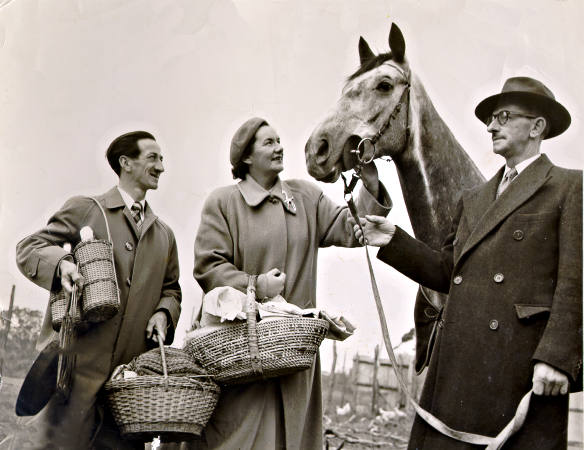
Jockey Jack Purtell, Ernest Willmott trainer, with Mrs Eileen May and horse Durham at Braeside Park 1947. Courtesy Shirley (Willmott) Morgan, Kingston Collection.
Hubert Opperman: Champion Cyclist
Born at Rochester in 1904, Hubert Opperman became a sporting star who, by the 1930s, rivalled Phar Lap and Bradman as a top Australian performer. Oppy won a cycle race as a teenager, the prize being a Malvern Star bike presented by Bruce Small who gave young Hubert a job in his cycle business. Riding Malvern Star machines Oppy won the Australian Road Titles in 1924 and added three more such titles in the 1920s.
The Melbourne Herald and the Sporting Globe newspapers organised sponsorship for Oppy to ride in the 1928 Tour de France. He had to contend with European teams of ten riders who made it tough for an Aussie team of four. Oppy finished 16th and, competing again in 1931, he made the top dozen. French cycling fans treated Oppy as a star, impressed by the talent of the young Australian who won other endurance road races during his trips to Europe. He was even voted the most popular European sportsman in a French newspaper survey during the early 1930s.
At the same time Oppy also became famous in Australia. He was involved in many endurance events, especially his 2875-mile ride from Fremantle to Sydney in a record 13 days over unmade roads. He did the fastest time in the Warrnambool to Melbourne and broke all sorts of records, including staying in the saddle for the longest period and other endurance events. His career was cut short by World War 2 when he joined the RAAF in 1940. He retired after war ended. Oppy had a connection with Mentone and Mordialloc from the 1930s onwards. He was always available for local fund-raisers, at the Mordialloc Carnival and elsewhere, giving demonstrations of speed cycling on rollers at schools and public events. During the forties Oppy, married with two children, lived on the corner of Naples Road and Palermo Street, his home eventually being bought by St Bede’s College.
In 1949 Oppy moved to Geelong where he won the Federal seat of Corio for the Menzies-led Liberal Party. He served the government until 1966, having been Minister for Immigration during the 1960s when the first steps were taken to soften the strict ‘White Australia Policy’. In the period 1967-72 Hubert Opperman became High Commissioner for Malta and then retired having received many honours, including an OBE and a knighthood. He died in 1996.
Dick Garrard: Olympic Wrestler
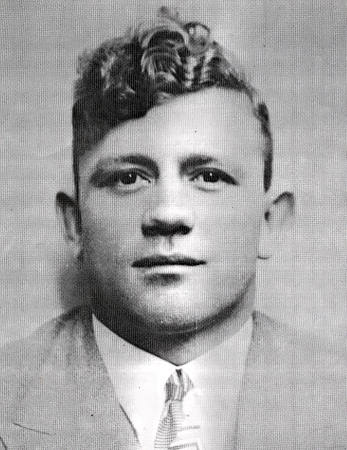
Dick Garrard Lightweight Olympic Wrestler at Berlin Games. Courtesy Mordialloc and District Historical Society.
Dick Garrard was born in Geelong in 1911. The family moved to Mordialloc where, in 1916, he started school at St Brigid’s. During the 1920s Dick was noted in the district for being very talented at several sports. In 1929 he came second in the arduous swimming contest between Mentone Baths and Mentone Pier, a distance of more than a kilometre in open sea. Dick also played football and cricket locally. In 1930 he took up freestyle wrestling and by 1934 had won the Australian middleweight title. This gained him a place in the Empire Games (now Commonwealth Games) in London where he won a gold medal as a lightweight, becoming Australia’s first wrestling medallist at any Games. He continued his dominance at the Empire Games by winning gold medals at the 1938 Sydney Games and in Auckland where the first post-war contest was held in 1950. Dick competed at Vancouver in 1954 taking the bronze medal in his last Games appearance.
At the Olympic level Garrard wrestled at Berlin in 1936, London in 1948 and Helsinki in 1952. He won silver as a welterweight at London. At that Olympics Australia won its first wrestling medals with Aussie heavyweight, Jim Armstrong, also doing well by winning a bronze medal. Dick was appointed team manager for wrestling after he retired in 1956, having missed selection for the Melbourne Games. In his whole career he had 525 bouts and lost just 9, a record that any sportsperson would be proud of.
During and after his competitive career Dick Garrard was generous in helping local groups, including schools, to raise funds when he attended functions to demonstrate wrestling tactics. He was often on the same program as Oppy and his cycling demonstrations on rollers.
Nancye Wynne Bolton: Tennis Star
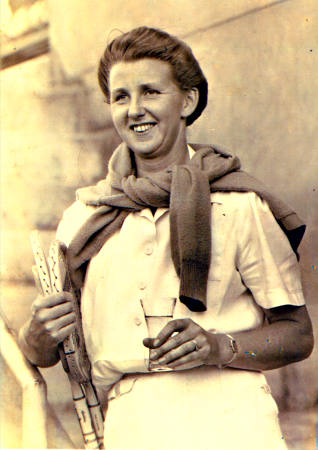
Nancye Wynne Bolton in Adelaide after winning the Australian Women’s Singles Title. Courtesy Pam Stockley.
The Wynne family lived on the corner of Florence Street and Plummer Road and their property included a bitumen tennis court. As a ten-year-old in 1927 Nancye received tennis coaching in the city and shortly after this began winning against much older girls at Mentone Girls’ Grammar School. When she was fifteen she won two doubles titles at Mentone’s tennis festival where grass courts were created on Mentone cricket ground during the New Year period in 1932. Nancye grew to be a strong woman. She was 5 feet 10 inches tall and moved from local tennis to play in State championships with success. Nancye reached the top of her chosen sport in 1937 when she won the Australian ladies singles title. With Nell Hopman, wife of Harry, the Davis Cup captain, Nancye and other young women toured England in 1938, gaining valuable experience.
In 1941 she married Pilot Officer Bolton. The next year he was shot down over Germany and Nancye became a widow with a baby girl, Pam. She never re-married.
In post-war years, as Nancye Bolton, she became the most successful female tennis player that Australia had produced to that stage. Including her 1937 success, Nancye won a total of six Australian singles titles as well as fourteen Australian doubles championships, ten partnered by Thelma Coyne, and four mixed events with Colin Long. Her twenty championship wins in the period between the 1930s and the early 1950s is the best effort by any Australian woman apart from Margaret Court who won many more events including international majors. Nancye concentrated on domestic tennis, her best overseas effort being runner up in the US Open in 1938.
Nancye Bolton was inducted into the Tennis Hall of Fame in 2001, shortly before she died.
Final Note
There were other sporting personalities in the local area in the mid-twentieth century. Ashley Reed lived in Mentone Parade during the 1940s and earlier. He was the jockey who booted The Trump home in the 1937 Melbourne Cup and the Caulfield Cup as well. Many other well-known jockeys lived in the Mentone-Mordialloc district as there were racecourses in both suburbs at that time.
The Boorers, especially Horace and Len, were very successful professional golfers. Horace won the Victorian Golf Open in 1927, 1933 and 1935. He was also the professional at Woodlands Golf Club from the mid-1920s until after World War 2. He played in a large number of tournaments against the era’s top golfers up till the 1950s. Although not as well known as players like Ferrier, Pickworth and Von Nida, he had a long career and at one stage ran a sports store. His Mentone addresses included Naples Road and Mentone Parade during the pre-war years.
Bruce Andrew did not grow up in our local area, but he lived in Parkdale in the immediate post-war period. Bruce involved himself in local events, including the Mordialloc Carnival, and gave talks to Mentone school students on football tactics. The Collingwood premiership player in the teams of 1928 and 1930 was a VFL administrator on the Australian National Football Council and also a panel member on TV’s World of Sport, where he judged kicking skills in an inimitable way.
Alec Hillhouse was a student at Mentone Grammar during the 1920s. He was an athlete with great endurance who went to the Empire Games in 1930 at Hamilton, Canada, and competed in the 10,000 metres event. He was also a member of the Olympic team at Los Angeles in 1932.
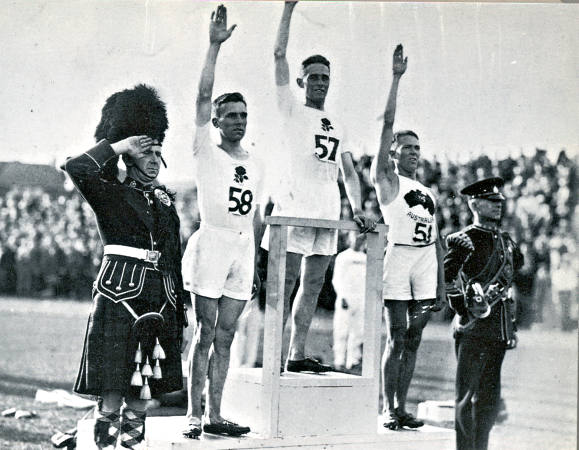
Alex Hillhouse at the British Empire Games at Hamilton, Canada 1930. He was placed second in the three mile event. Courtesy Mentone Grammar School.
There are many more locals with a claim to high level sporting success. In this short article it is not possible to deal with them all.
